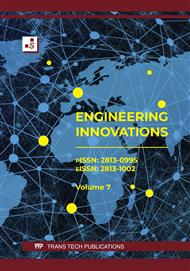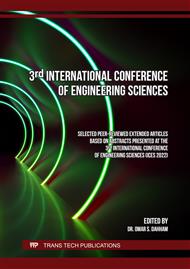[1]
Mook W. T., Chakrabarti M. H., Aroua M. K. Removal of total ammonia nitrogen (TAN), nitrate and total organic carbon (TOC) from aquaculture wastewater using electrochemical technology: A review Desalination. 2 (2012) 85-113.
DOI: 10.1016/j.desal.2011.09.029
Google Scholar
[2]
Turhan K. Durukan I., Ozturkcan S. A., Turgut Z. Decolorization of Textile Basic Dye in Aqueous Solution By Ozone Dyes Pigment. 92 (2012) 897-901.
DOI: 10.1016/j.dyepig.2011.07.012
Google Scholar
[3]
Kim K., HIhm S. K. Heterogeneous Catalytic Wet Air Oxidation of Refractory Organic Pollutants in Industrial Wastewaters: A review J. Hazard. Mater. 186(2011) 16-34.
DOI: 10.1016/j.jhazmat.2010.11.011
Google Scholar
[4]
Yang G. C., Li C. J. Electrofi Literation of Silica Nanoparticle-containing Wastewater Using Tubular Ceramic Membranes. Sep. Purif. Technol. 58 (2007) 159-165.
DOI: 10.1016/j.seppur.2007.07.019
Google Scholar
[5]
Focus technology go ltd. Water Treatment System (Active Carbon Filter) Zhangjiagang Beyond Machinery Co. Ltd (2012).
Google Scholar
[6]
Chu L., Wang J. Dong J., Liu H., Sun X. Treatment of Coking Wastewater by an Advanced Fenton Oxidation Process Using Iron Powder and Hydrogen Peroxide. Chemosphere. 86 (2012) 409-414.
DOI: 10.1016/j.chemosphere.2011.09.007
Google Scholar
[7]
Li S., Zhou P., Yao P. Preparation of O-Carboxymethyl-N-Trimethyl Chitosan Chloride and Flocculation of the Wastewater in Sugar Refinery J. Appl. Polym. Sci. 116 (2010) 2742-2748.
DOI: 10.1002/app.31899
Google Scholar
[8]
Grilli S., Piscitelli D., Mattioli D., Casu S., Spagni A. Textile Wastewater Treatment in a Bench-scale Anaerobic-biofilm Anoxic-aerobic Membrane Bioreactor Combined with Nanofiltration J. Environ. Sci. Heal A-Tox. Hazard. Subst. Environ. Eng. 46 (2011) 1512-1518.
DOI: 10.1080/10978526.2011.609078
Google Scholar
[9]
Fibbi D., Doumett S., Lepri L., Checchini L., Gonnelli C., Coppini E., Bubba M. D. Distribution and Mass Balance of Hexavalent and Trivalent Chromium in a Subsurface, Horizontal Flow (SF-h) Constructed Wetland Operating as Post-treatment of Textile Wastewater for Water reuseJ. Hazard. Mater. 199 (2012) 200-209 EOF216 EOF.
DOI: 10.1016/j.jhazmat.2011.10.089
Google Scholar
[10]
Wu W. E., Ge H. G., Zhang K. Wastewater biological treatment technology. Chemical Industry Press (CIP) Publishing: BeiJing, In Chinese. (2003)
Google Scholar
[11]
Ahmed F. N., Lan C. Q. Treatment of Landfill Leachate Using Membrane Bioreactors: A Review Desalination. 287 (2012) 41-54.
DOI: 10.1016/j.desal.2011.12.012
Google Scholar
[12]
Herney-ramirez, Vicente M.A., Madeira L.M., 2010. Heterogeneous Photo-Fenton Oxidation with Pillared Clay-based Catalysts for Wastewater Treatment: A review Appl. Catal., B. 98 (2010) 10-26.
DOI: 10.1016/j.apcatb.2010.05.004
Google Scholar
[13]
Van den Berg M., Birnbaum L, Bosveld ATC.Toxic Equivalency Factors (TEFs) for PCBs, PCDDs, PCDFs for Humans and Wildlife.Environ. Health Perspect. 106 (1998)775-792.
DOI: 10.1289/ehp.98106775
Google Scholar
[14]
Pope C. N. Organophosphorus pesticides: Do they all have the same Mechanism of Toxicity? J. Toxicol. Env. Heal. B. 2 (1999) 161-181.
Google Scholar
[15]
Mohammadi L., Rahdar A., Bazrafshan E. Petroleum Hydrocarbon Removal from Wastewaters: A Review. 134 (2020).
Google Scholar
[16]
Fujishima A., Zhang X., Tryk D. A. TiO2 Photo catalysis and Related Surface Phenomena. Surf. Sci. Rep. 63(2008) 515-582.
DOI: 10.1016/j.surfrep.2008.10.001
Google Scholar
[17]
Gogate P. R., Pandit A. B. A Review of Imperative Technologies for Wastewater Treatment I: Oxidation Technologies at Ambient Conditions Adv. in Environ. Res. 8 (2004)501-551.
DOI: 10.1016/s1093-0191(03)00032-7
Google Scholar
[18]
Pirkanniemi K., Metsärinne S., Sillanpää M. Degradation of EDTA and Novel Complexing Agents in Pulp and Paper Mill Process and Wastewaters by Fenton's Reagent. J. Hazard. Mater. 147 (2007) 556-561.
DOI: 10.1016/j.jhazmat.2007.01.050
Google Scholar
[19]
Fernandez-ibanez P .,Blanco J., Malato S. Application of the Colloidal Stability of TiO2 Particles for Recovery and Reuse in Solar Photocatalysis.Water Res. 37 (2003) 3180-3188.
DOI: 10.1016/s0043-1354(03)00157-x
Google Scholar
[20]
Doll T. E., Frimmel F. H. Cross-flow Microfiltration with Periodical Back-washing for Photo catalytic Degradation of Pharmaceutical and Diagnostic Residues-evaluation of the Long-term Stability of the Photo. 39 (2005) 847-854.
DOI: 10.1016/j.watres.2004.11.029
Google Scholar
[21]
Yetis M., Gu Èndu Èz U., Eroglu I. Photoproduction of Hydrogen from Sugar Refinery Wastewater by Rhodobacter sphaeroides O.U. 001, Int. J. Hydrogen Energ. 25(2000) 1035-1041.
DOI: 10.1016/s0360-3199(00)00027-6
Google Scholar
[22]
Lin S. H. Chuang T. S. Wet Air Oxidation and Activated Sludge Treatment of Phenolic Wastewater. Environ. Sci. Health A. 29(1994) 547-564.
Google Scholar
[23]
Mantzavinos D., Hellenbrand R., Metcalfe I. S., Livingston A. G. Partial Wet Oxidation of P-coumaric Acid: Oxidation Intermediates, Reaction Pathways and Implications for Wastewater Treatment Water Res. 30 (1996) 2296-92976.
DOI: 10.1016/s0043-1354(96)00202-3
Google Scholar
[24]
Trujillo D., Font X., Sanchez A. Use of Fenton Reaction for the Treatment of Leachate from Composting of Different Wastes J. Hazard. Mater. B. 138 (2006)201-204.
DOI: 10.1016/j.jhazmat.2006.05.053
Google Scholar
[25]
Navalon S., Alvaro M., Garcia H., 2010. Heterogeneous Fenton Catalysts Based on Clays, Silicas and Zeolites Appl. Catal., B. 99 (2010)1-26.
DOI: 10.1016/j.apcatb.2010.07.006
Google Scholar
[26]
Deng Y., Englehardt J . D., 2006. Treatment of Landfill Leachate by the Fenton ProcessWater Res. 40 (2006) 3683-3694.
DOI: 10.1016/j.watres.2006.08.009
Google Scholar
[27]
Yili Fang, Weizhao Yin, Yanbin Jiang, H. Ge, Ping Li, Jinhua Wu. Depth treatment of coal-chemical engineering wastewater by a cost-effective sequential heterogeneous Fenton and biodegradation process. Enginering Environmental Science and Pollution Research. 25 (2018) 13118-13126.
DOI: 10.1007/s11356-018-1571-8
Google Scholar
[28]
Yu Q. Y. Advances in the treatment of printing and dyeing wastewater. Industrial Safety and Environmental Protection. 37 (2011) 41-43In Chinese.
Google Scholar
[29]
Fongsatitkul P., Elefsiniotis P., Yamasmit A., Yamasmit N. Use of Sequencing Batch Reactors and Fenton's Reagent to Treat a Wastewater from a Textile Industry Biochem. Eng. J. 21(2004) 213-220.
DOI: 10.1016/j.bej.2004.06.009
Google Scholar
[30]
Yang D. M., Wang B. Application of advanced oxidation processes in papermaking wastewater treatment China pulp and paper. 29(2010) 69-73In Chinese.
Google Scholar
[31]
Leahy J.G., Colwell R. R. Microbial-Degradation of Hydrocarbons in the Environment. Microbiol. R. 54 (1990) 305-315.
DOI: 10.1128/mr.54.3.305-315.1990
Google Scholar
[32]
Scott J. P. Ollis D. F. Integration of Chemical and Biological Oxidation Processes For Water Treatment: Review and Recommendations Environ. Prog. 14 (1995) 88-103.
DOI: 10.1002/ep.670140212
Google Scholar
[33]
Peng Y., Hou H.,Wang S., Cui Y., Zhiguo Y. Nitrogen and Phosphorus Removal in Pilot-Scale Anaerobic-Anoxic Oxidation Ditch SystemJ Environ Sci 20 (2008) 398-403.
DOI: 10.1016/s1001-0742(08)62070-7
Google Scholar
[34]
Kassab G., Halalsheh M., Klapwijk A., Fayyad M. Van, LierJ. B., 2010. Sequential Anaerobic-Aerobic Treatment for Domestic Wastewater- A Review. Bioresour. Technol. 101(2010) 3299 - 3310.
DOI: 10.1016/j.biortech.2009.12.039
Google Scholar
[35]
Ka-car Y., Alpay E., Ceylan V. K. Pretreatment of Afyon Alcaloide Factory's Wastewater by Wet Air Oxidation (WAO), Water Res. 37(2003)1170-1176.
DOI: 10.1016/s0043-1354(02)00448-7
Google Scholar
[36]
Patterson J. W. Industrial wastewater treatment technology Second Edition. Butterworth Publishers, Stoneham, MA. USA. (2008)
Google Scholar
[37]
Matavos-Aramyan S. Moussavi M., Advances in Fenton and Fenton Based Oxidation Processes for Industrial Effluent Contaminants Control-A Review. 2 (2017) 1-18
DOI: 10.19080/ijesnr.2017.02.555594
Google Scholar
[38]
Schoneich C. 2022, Advanced Oxidation Processes in Pharmaceutical Formulations: Photo-Fenton Degradation of Peptides and Proteins. International Journal of Molecular Science. 23 (2022) 1-9.
DOI: 10.3390/ijms23158262
Google Scholar
[39]
Bayar, S., Erdogan, M, 2019, Removal of COD and color from reactive red 45 azo dye wastewater using fenton and fenton-like oxidation processes: kinetic studies.17 (2019) 1-13.
DOI: 10.15666/aeer/1702_15171529
Google Scholar




